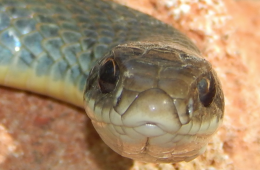Cats and Snakebite

Why do cats have a much better chance than dogs of surviving venomous snakebites? That cats do survive better has been known for years, but no-one has worked out the reason. To give an example; the eastern brown snake (Pseudonaja textilis) is responsible for an estimated 76 percent of all reported Australian domestic pet snakebites each year. Studies at the University of Queensland have shown that 66% of cats survive being bitten by the eastern brown snake even without treatment with antivenom. In contrast, fewer than half that number of dogs (31%) survive. Cats also have a significantly higher survival rate if given antivenom treatment.
Usually, a larger animal has a better chance of survival, but since cats are much smaller than dogs, the answer to the different survival rates must lie in how the venom affects the blood. Snake venom induces a condition called 'venom-induced consumptive coagulopathy'. Coagulopathy (a bleeding disorder) is a condition in which the blood's ability to coagulate (form clots) is impaired. In consumptive coagulopathy blood clotting agents are consumed by the body. As a result, the animal loses its ability to clot blood and bleeds to death.
So why are cats much better at surviving? PhD student Christina Zdenek and Associate Professor Bryan Fry from the University of Queensland reckon they now have a good idea. They looked at blood plasma from cats, dogs and humans (for comparison) to see how the plasma responded to different types of venom. For this they used a coagulation analyzer - a laboratory instrument capable of measuring blood clotting characteristics such as the speed of clotting and the amounts of different clotting agents.
The researchers used samples of venom from ten breeds of snake from different parts of the world including the eastern brown snake (Pseudonaja textilis) mentioned above. Normally a dog's blood will clot faster than that of a cat or of a human. Yet the tests showed exactly the opposite effect when the blood was exposed to snake venom. All venoms acted faster upon dog plasma than that of cat or human, indicating that dogs would likely enter coagulopathic states sooner. (A coagulopathic state is one where the blood fails to clot, causing damage to muscles, joints and internal organs.)
As well as the physiological difference in blood, the authors think that behavioural differences may play a role. Dogs are generally more active than cats which means that their blood flow is faster, so when snake venom enters the bloodstream it moves quickly through the body. Dogs also rely a lot on smell, so they are likely to be bitten around the facial area which is rich in blood vessels. Cats on the other hand tend to dab at a snake with a paw where the skin is harder to penetrate and the protective fur is thicker.
In summary, when it comes to snakebite, at least one of a catís traditional nine lives has a scientific explanation.
Journal Reference:
Christina N. Zdenek, Joshua Llinas, James Dobson, Luke Allen, Nathan Dunstan, Leijiane F. Sousa, Ana M. Moura da Silva, Bryan G. Fry. Pets in peril: The relative susceptibility of cats and dogs to procoagulant snake venoms. Comparative Biochemistry and Physiology Part C: Toxicology & Pharmacology, (2020); vol 235 pp.108769
https://www.sciencedirect.com/science/article/abs/pii/S1532045620300697?via%3Dihub
Note: This information is for guidance only. It is not intended to replace consultation with a licensed practitioner.
